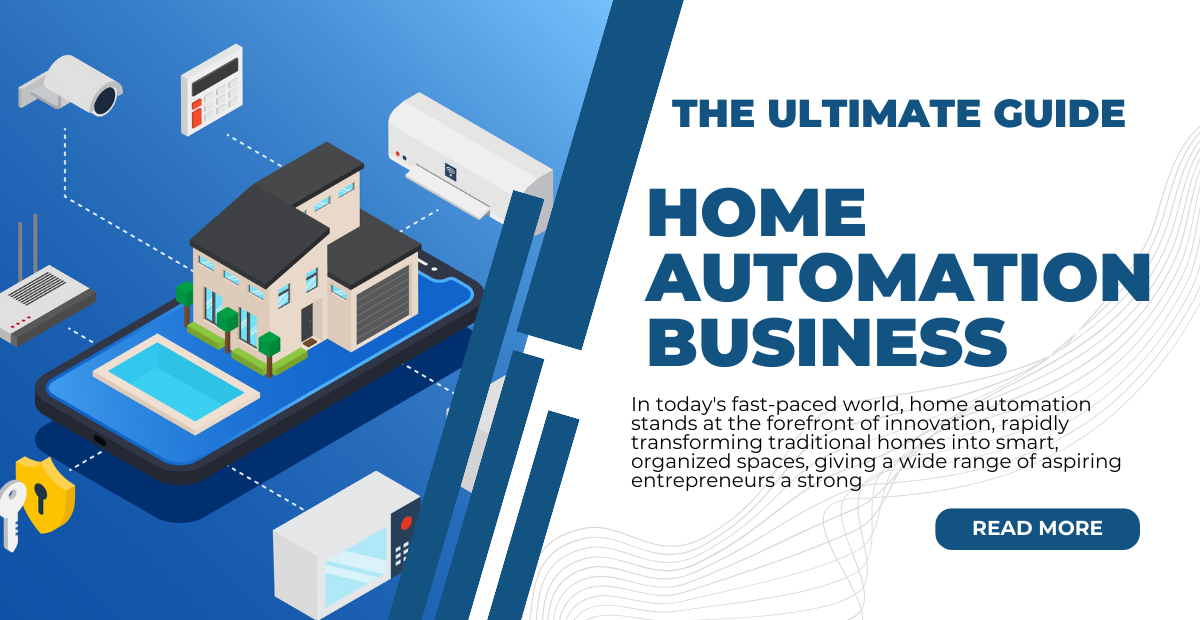In today’s fast-paced world, home automation stands at the forefront of innovation, rapidly transforming traditional homes into smart, organized spaces, giving a wide range of aspiring entrepreneurs a strong, long-lasting, and successful home automation experience. Provides the information necessary to set up and grow a business, its pros and cons, and strategies to design, understand the dynamics of the domestic automotive industry and provide effective marketing and essential strategies. Memorizing Each section of this article is designed to provide thoughtful and practical advice, so stay tuned for the next step.
1. Introduction
Overview of the Home Automation Industry
Home automation, also known as smart home technology, refers to the automatic control of existing conditions and systems within the home, such as lighting, handling, ventilation, air conditioning, security, and many other entertainment functions that are considered to be high-end. What was once thought of as tech has now become an integral part of modern life, providing homeowners with access to superior energy efficiency and superior security.
Importance and Growth of the Industry
The global home automation market has experienced important growth in recent years, driven by advancements in technology, collective consumer demand for connected devices, and the rise of IoT (Internet of Things). According to market research, the industry is projected to continue growing, with smart home device approval expected to grow exponentially across many regions.
2. Understanding Home Automation

What is Home Automation?
Home automation basically involves the use of technology to enable better and easier regional control and management of indoor conditions and systems, including automatic lighting, smart control, car brands, smart security systems, and entertainment systems. Regular includes that can be remotely controlled and monitored by smartphone or assistants
Definition and Examples of Home Automation Systems
Home automation systems cover a very wide range of products and technologies. For example, smart lighting systems such as Philips Hue allow users to adjust lighting settings via mobile apps and monitor, maintain, and level light levels. In addition, smart thermostats like Next Learning Control learn homeowner preferences and manage temperature rejection to adjust energy use and energy levels.
Benefits of Home Automation
Efficiency: Energy automation systems improve efficiency, resulting in reduced bill efficiency and environmental impact
Convenience: Remote control allows homeowners to adjust and improve their home systems from anywhere, increasing accessibility and flexibility.
Security: Security systems provide real-time monitoring and alerts for beautifully secure home control and peace of mind.
Energy saving: Automatic adjustment takes into account the accommodation and weather conditions and controls the energy saving and adjustment function over time.
Current Market Trends
The home automation market has been characterized by rapid technological advancements and growing consumer preferences, including the addition of AI and machine learning capabilities to smart devices and the creation of voice-controlled assistants such as Amazon Alexa and Google Assistant. And further includes the growing demand for interoperability between different smart home platforms
3. Market Research and Planning

Identifying Your Niche
Before starting a strong and successful home automation business, it is very important to identify a specific niche or niche in the market, be it catering to specific types of smart devices such as security systems, entertainment solutions, or specific customer segments such as residential and commercial clients. Is
Target Audience Analysis
A thorough understanding of the demographics of your target audience is critical to effectively changing your products and services. Conduct regular market research and insights
Competitive Analysis
Identify Your Competitors Assess Their Strengths and Weaknesses Gain a Full Experience of the Home Automation Bari to Gain a Fast-Market Advantage and Start a Successful Business Differentiating your business intent through unique offerings, superior customer service or innovative solutions is critical
4. Legal and Regulatory Considerations

Business Structure
Arrange an appropriate legal structure for your home automation business such as a Sole Proprietorship, Limited Liability Company, LLC, or Corporation. Make choices that align with your long-term goals and risk tolerance
Licensing and Permits
Regularly research and obtain the licenses, permits, or certifications necessary to operate a home automation business in your jurisdiction, including electrical licenses, building permits for the organization’s work, and specific directions related to data privacy and security. and involves strict regulatory compliance
Insurance Needs
Check the insurance option for home automation service including general liability insurance professional liability insurance and property insurance policy to cover any major or minor damage to equipment and installations.
5. Planning Your Business Operations

Business Plan Essentials
Develop a comprehensive and robust business plan that outlines your business goals, target market, distance, marketing experience, strategy, options, budget, and financial projections. A crore serves as a roadmap and is critical to attracting investors or securing financing
Setting Up Your Office
Manage your office or workspace with the necessary tools, equipment, and hardware for designing an optimal home automation system, programming and testing it, including computer programming tools, diagnostics, and system integration simulation software.
Supplier and Partner Relationships
Establish a good and strong relationship with renowned manufacturers Bestibuters and GLO Automation products and suppliers Reliable supplier relationships Quality products Power access Competitive pricing and on-time delivery ensure customer satisfaction and required performance are very important because of which the customer’s trust in you increases
6. Financial Considerations

Startup Costs
Estimate the initial investment to start your home automation business, including the purchase of equipment, entry marketing, and advertising costs, legal fees, insurance premiums, and initial working capital, both one-time start-up costs and optional costs incurred while preparing your own home automation business. Make estimates and consider them regularly
Revenue Streams
Identify regular revenue streams for your home automation business such as product sales (eg, smart devices control panels) and their installation services, maintenance contracts, subscription-based monitoring and services, and regular revenue consulting fees for custom system design and configuration. point out
Financial Projections
Market research Projected sales volume Pricing strategies and pricing strategies Cost of goods sold Make realistic financial forecasts based on operating expenses and expected cash flows Current market conditions to reflect changes in customer needs and business performance Review your financial projections regularly and daily and stay updated with all these situations
7. Marketing and Sales Strategies

Brand Development
Create a strong brand identity that reflects the company’s values, mission, and unique selling proposition (USP). Your business will be known as a brand if you are determined to differentiate it from competitors
Digital Marketing Tactics
Implement a comprehensive and compelling digital marketing strategy to drive website traffic to increase your brand awareness and generate leads among your target audience and convert them into customers Key Digital Marketing Strategy Search Engine Optimization (SEO) Pay Per Click (PPC) Advertising Content Marketing (e.g. blogging, video tutorials) Social Media Marketing Email Marketing Campaigns Establish a structured and robust online relationship system.
Lead Generation and Conversion
Implement a targeted lead generation strategy to attract millennials interested in home automation solutions to your service product or products Offer free resources (e.g. eBooks and white papers) on smart home technology trends and their Conduct webinars or workshops to promote the benefits and optimize the lead pages and call-to-action buttons on your website to effectively capture leads and convert customers.
8. Operational Execution

Installation and Service Delivery
Ensure customer satisfaction to enable optimal performance and successful business and implement best practices for installation, testing, and commissioning of home automation systems to further extend its lifecycle Product Features Technical Specifications to your installation team Provide regular in-class training on troubleshooting techniques and customer service standards to ensure customer satisfaction by providing consistent and high-quality service.
Customer Support
Providing exceptional customer service support is essential to building trust, loyalty, and long-term relationships with our customers by offering timely responses to customer comments, technical support assistance, troubleshooting guidance, and proactive maintenance services problems can be solved immediately and the uptime and performance of the installed systems can also be ensured
Managing Growth
Plan for Scalability and Smartness As your home automation business grows, hire skilled people with expertise in system design, installation, programming, and customer service to meet growing demand efficiently, safely, and with high quality. Deliver quality of service to the customer Don’t hesitate to invest in employee training programs Optional process upgrades and more automation tools and technology to further improve efficiency Reduce costs and increase overall business performance Get more out of
9. Future Trends and Innovations

Emerging Technologies
Stay up-to-date with the technology and industry trends that are driving and shaping the future of automation AI machine learning voice recognition to innovate your product Google Assistant Google Assistant and smart home automation platform Apple Home’s Samsung Further enhance the ability to discover developments such as and tailor smart home experiences to customer preferences
Adapting to Market Changes
Conduct behavioral research within the home automation industry Develop robust strategies to adapt to changes in regulatory developments and competitive dynamics Continuously and regularly monitor market trends Collect customer feedback and product Leverage data visualization to innovate and identify service enhancements and broader market opportunities Build your business operations with robust strategic planning and resource allocation flexibility to respond quickly and more to emerging opportunities. Get the most out of what suits your business objectives and growth strategy
10. Conclusion
Final Thoughts
Ultimately, starting a strong and successful home automation business requires careful planning, strategic execution, and a commitment to providing exceptional customer value and service, along with certified knowledge, technical skills, experience, and effective business management practices. By leveraging more, aspiring entrepreneurs can navigate the complexities of the home automation market and launch their own strong businesses, take advantage of growth opportunities, and create a successful and sustainable long-term business plan.
Encourage Action
Encourage your leader to take actionable steps to realize their business ambitions in this growing field of home automation. To achieve business success and long-term profitability, your business must continually learn to keep pace with technological advancements and customer needs. Emphasize the importance of focused attention

